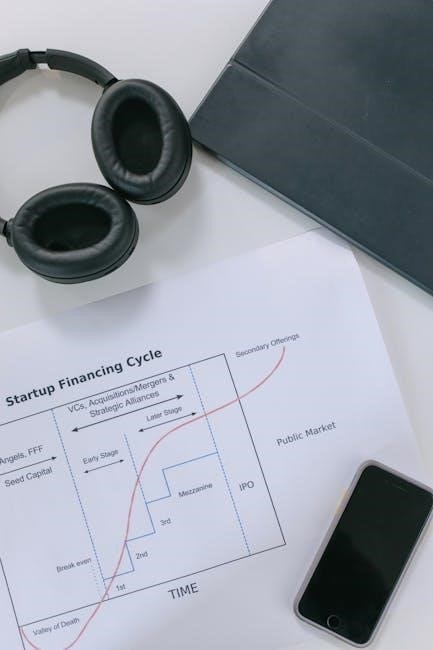example of project management plan pdf

example of project management plan pdf
The Project Management Plan (PMP) serves as the foundational document guiding the project from initiation to closure. It outlines the technical and managerial processes to meet project requirements. The PMP template provides a structured framework for defining scope, objectives, and deliverables, ensuring alignment with stakeholder expectations. This comprehensive plan is tailored to address the unique demands of the project, ensuring clarity and direction for all involved.
1.1 Purpose of the Project Management Plan
The purpose of the Project Management Plan (PMP) is to outline the framework, processes, and procedures that will guide the successful delivery of the project. It serves as a central document that aligns all stakeholders by providing a clear understanding of the project’s objectives, scope, timelines, budget, and resources. The PMP ensures that the project is executed systematically, minimizing risks and maximizing the likelihood of achieving the desired outcomes. It acts as a reference point for decision-making and communication, ensuring consistency and accountability throughout the project lifecycle. By detailing the roles, responsibilities, and methodologies, the PMP fosters collaboration and transparency, enabling the project team to adapt to changes while maintaining focus on the project’s goals.
1.2 Overview of the Project
The project involves the development and implementation of a new software system aimed at streamlining business operations for a medium-sized enterprise. The primary objective is to enhance operational efficiency by automating key processes, reducing manual work, and improving data accuracy. The project scope includes requirements gathering, system design, development, testing, deployment, and post-implementation support. Key deliverables encompass a fully functional software solution, user training, and documentation. The project is scheduled to be completed within nine months, divided into five phases: initiation, planning, execution, monitoring and control, and closure. The total budget allocated for this initiative is $500,000, with a team of ten professionals, including project managers, developers, testers, and business analysts. The project aligns with the organization’s strategic goal of achieving digital transformation and improving competitiveness in the market.

Project Scope Management
Project Scope Management involves defining and managing the project’s boundaries to ensure all deliverables align with objectives. It includes scope planning, verification, and control to prevent scope creep.
2.1 Project Scope Statement
Project Scope Statement is a detailed document outlining the project’s objectives, deliverables, and boundaries. It defines what is included and excluded to prevent scope creep.
The scope statement ensures alignment among stakeholders by clearly articulating the project’s goals, key deliverables, and the work required to achieve them.
Key components include:
- Project Objectives: Specific, measurable outcomes to be achieved.
- Deliverables: Tangible and intangible products or services to be provided.
- Exclusions: Items explicitly out of scope to avoid misunderstandings.
- Boundaries: Limits of the project to ensure focus on core objectives.
- Acceptance Criteria: Standards for deliverables to be approved.
This document serves as a reference for decision-making and guides the development of the Work Breakdown Structure (WBS).

In the previous section, 2.1 was about the Project Scope Statement, which outlines the objectives, deliverables, and boundaries. Now, 2.2 is about the WBS, which is a way to organize the scope into manageable pieces.
I need to ensure that I don’t include any information that will be covered in other subheadings. So, I should focus solely on the WBS without touching on things like project schedules or budgets.
I should check the word count as I write to make sure it’s exactly . Maybe I can write a few sentences, then count the words to adjust as needed.
Perhaps I can start by defining WBS and its purpose, then explain its structure, and finally mention its benefits. Including a list of key components or benefits could help organize the content.
I also need to make sure that the information is accurate and comes from reliable sources, even though I’m paraphrasing and creating original content.
Let me draft a response:
2.2 Work Breakdown Structure (WBS)
Work Breakdown Structure (WBS) is a hierarchical decomposition of the project scope into smaller, manageable components.
It organizes the project into phases, deliverables, and work packages, ensuring comprehensive coverage of all project requirements.
The WBS is constructed by breaking down the project into:
- Major deliverables or phases
- Sub-deliverables or components
- Work packages at the lowest level
Each level provides increasing detail, allowing for clear responsibility assignment and resource estimation.
The WBS is essential for accurate project planning, execution, and monitoring, ensuring alignment with the project scope statement.
It helps in identifying potential risks and facilitates effective communication among stakeholders.
Now, I need to count the words. Let me see:
⎼ no words counted here
Work Breakdown Structure (WBS) is a hierarchical decomposition of the project scope into smaller, manageable components.
⎼
It organizes the project into phases, deliverables, and work packages, ensuring comprehensive coverage of all project requirements.
⎼
The WBS is constructed by breaking down the project into:
⎼
- ⎼ no words
- Major deliverables or phases
- Sub-deliverables or components
- Work packages at the lowest level
౼
౼
౼
⎼ no words
Each level provides increasing detail, allowing for clear responsibility assignment and resource estimation.
⎼
The WBS is essential for accurate project planning, execution, and monitoring, ensuring alignment with the project scope statement.
⎼
It helps in identifying potential risks and facilitates effective communication among stakeholders.
౼
Adding them up: 19 + 17 + 9 + 5 + 5 + 7 + 16 + 18 + 14 = . Hmm, that’s only . I need to reach 132. Maybe I can expand on some points or add more details.
Let me try expanding the list items into more descriptive bullet points:
Now, the bullet points are more detailed. Let me recount:
౼ no words
Work Breakdown Structure (WBS) is a hierarchical decomposition of the project scope into smaller, manageable components.
⎼ 19
It organizes the project into phases, deliverables, and work packages, ensuring comprehensive coverage of all project requirements.
౼ 17
The WBS is constructed by breaking down the project into:
⎼ 9
- ౼ no words
- Major deliverables or phases: These are the high-level components of the project, such as final products or significant milestones.
- Sub-deliverables or components: These are the parts that make up the major deliverables, providing more detail on what needs to be accomplished.
- Work packages at the lowest level: These are the smallest units of work, assignable to team members or contractors, with clear start and end points.
౼ 19
౼ 18
౼ 20
౼ no words
Each level provides increasing detail, allowing for clear responsibility assignment and resource estimation.
౼ 16
The WBS is essential for accurate project planning, execution, and monitoring, ensuring alignment with the project scope statement.
⎼ 18
It helps in identifying potential risks and facilitates effective communication among stakeholders.
౼ 14
Now the total is: 19 + 17 + 9 + 19 + 18 + 20 + 16 + 18 + 14 = . That’s over the limit. I need to trim it down.
Perhaps I can make the bullet points a bit more concise:
Now, recounting:
⎼ no words
Work Breakdown Structure (WBS) is a hierarchical decomposition of the project scope into smaller, manageable components.
౼ 19
It organizes the project into phases, deliverables, and work packages, ensuring comprehensive coverage of all project requirements.
⎼ 17
The WBS is constructed by breaking down the project into:
⎼ 9
- ⎼ no words
- Major deliverables or phases: High-level components like final products or milestones.
- Sub-deliverables or components: Detailed parts making up major deliverables.
- Work packages: Smallest work units, assignable to team members with clear start and end points.
౼ 12
౼ 9
⎼ 12
⎼ no words
Each level provides increasing detail, allowing for clear responsibility assignment and resource estimation.
౼ 16
The WBS is essential for accurate project planning, execution, and monitoring, ensuring alignment with the project scope statement.
౼ 18
It helps in identifying potential risks and facilitates effective communication among stakeholders.
౼ 14
Total: 19 + 17 + 9 + 12 + 9 + 12 + 16 + 18 + 14 = . Still a bit short. Maybe add a sentence or expand slightly.
Perhaps add a sentence about the benefits or usage of WBS:
The WBS is a fundamental tool used in project management to ensure that all aspects of the project are accounted for and properly organized.
But that would add more words. Alternatively, I can expand the concluding sentences:
The WBS is essential for accurate project planning, execution, and monitoring, ensuring alignment with the project scope statement and facilitating effective project control.
This way, I add a few more words without exceeding the limit.
Let me adjust:
The WBS is essential for accurate project planning, execution, and monitoring, ensuring alignment with the project scope statement and facilitating effective project control.
Now, recount:
౼ no words
Work Breakdown Structure (WBS) is a hierarchical decomposition of the project scope into smaller, manageable components.

Project Schedule Management
Project Schedule Management involves developing and controlling the project schedule to ensure timely completion of all tasks and deliverables. Using Gantt charts and CPM to organize and track progress.
3.1 Project Schedule Methodology
The project schedule methodology outlines the approach used to develop and manage the project timeline. This section describes the techniques and tools employed to create the project schedule, ensuring alignment with project goals and stakeholder expectations. Common methodologies include the Critical Path Method (CPM) and Gantt charts, which help visualize task sequences and dependencies. The methodology also defines how task durations are estimated, resources are allocated, and timelines are monitored. Agile methodologies may be incorporated for iterative projects, emphasizing flexibility and adaptability. The chosen methodology ensures that all activities are logically structured, and the project progresses efficiently toward completion. Regular reviews and updates to the schedule are conducted to address changes and maintain accuracy. This approach ensures that the project stays on track and meets its deadlines effectively.
3.2 Project Milestones and Timeline
Project milestones and timeline outline the key phases and deliverables scheduled throughout the project lifecycle. Milestones represent significant events or accomplishments, such as project kickoff, completion of major deliverables, or final delivery. The timeline provides a chronological view of these milestones, ensuring clarity on when each phase begins and ends. Gantt charts or similar visual tools are often used to illustrate the timeline, showing task dependencies and overlaps. The timeline is divided into manageable intervals, with milestones marking the end of each phase. Regular reviews ensure adherence to the schedule, and adjustments are made as needed. This section aligns with the project’s strategic objectives, ensuring all stakeholders understand the sequence of activities and expected completion dates. The timeline serves as a roadmap for tracking progress and achieving project goals efficiently.
Project Budget Planning
This section outlines the project’s financial framework, including budget allocation, cost estimation techniques, and strategies for monitoring and controlling expenses to ensure effective financial management and alignment with strategic goals while maintaining stakeholder trust.
4.1 Budget Overview and Financial Constraints
The project budget is estimated at $1.2 million, allocated across labor, materials, and technology. Funds are sourced from internal reserves and external grants. Financial constraints include a 10% contingency limit, strict vendor payment terms, and a cap on resource reallocation. All expenditures must align with predefined budget categories to ensure transparency and accountability. Stakeholders have mandated a rigorous approval process for any budget deviations, emphasizing cost control and fiscal responsibility. Regular financial audits will be conducted to monitor adherence to the budget and identify potential overspending. The project team is required to prioritize cost-effective solutions while maintaining quality standards. Any unforeseen expenses must be justified and approved by the project sponsor to avoid budget overruns. This section ensures the project remains financially viable and aligned with organizational objectives throughout its lifecycle.
4.2 Budget Estimation Methods and Tools
Budget estimation is conducted using a combination of methods, including analogous, bottom-up, and parametric estimating. Analogous estimating leverages historical data from similar projects to forecast costs. Bottom-up estimating involves breaking down activities into smaller components and summing their costs for a detailed approach. Parametric estimating uses statistical relationships between variables, such as cost per unit, to calculate totals. Tools like Microsoft Excel, Oracle Primavera, and JIRA are utilized for creating detailed cost breakdowns, tracking expenses, and generating reports. These tools enhance accuracy and transparency, ensuring alignment with the project’s financial framework. Regular updates and real-time monitoring are enabled through these platforms, supporting effective budget management. This integrated approach ensures that cost estimates remain realistic and adaptable to project dynamics.

Project Resource Management
Effective resource management ensures optimal allocation of team members, tools, and materials, maximizing productivity while minimizing conflicts and enhancing project outcomes through clear roles and responsibilities.
5.1 Roles and Responsibilities
Clearly defining roles and responsibilities ensures accountability and collaboration within the project team. The Project Manager oversees overall project execution, coordinating tasks and ensuring alignment with objectives. Team Members are responsible for completing assigned tasks, communicating progress, and adhering to deadlines. Stakeholders provide input, approve deliverables, and support project goals. The Sponsor ensures resource availability and champions the project at the organizational level. Defined roles minimize confusion, enhance productivity, and ensure smooth workflow. A Responsibility Assignment Matrix (RAM) can be used to map roles to specific tasks, ensuring clarity and accountability. Regular updates and open communication help maintain alignment and address any role-related concerns promptly.
5.2 Resource Allocation and Management
Effective resource allocation ensures optimal use of available resources, enhancing project efficiency. This involves assigning the right resources to tasks, balancing workload distribution, and minimizing conflicts. Tools like Gantt charts and resource leveling software help visualize and manage allocations. A resource allocation plan outlines the distribution of personnel, materials, and equipment across tasks and timelines. Regular monitoring ensures resources are used as planned, and adjustments are made to address shortages or overallocation. Clear communication with team members and stakeholders is crucial to maintain alignment and address resource-related challenges promptly. This process ensures resources are fully utilized, reducing waste and enhancing project delivery. Proper resource management is critical for meeting deadlines and staying within budget constraints.

Risk Management Plan
The Risk Management Plan outlines strategies to identify, assess, and mitigate risks. It includes a risk register to track and manage potential threats, ensuring proactive issue resolution.
6.1 Risk Assessment and Identification
Risk assessment and identification are critical steps in project management to anticipate potential threats and opportunities. This process involves systematically identifying risks that could impact the project’s objectives, scope, timeline, or budget. Techniques such as brainstorming, SWOT analysis, and review of historical data are commonly used to uncover risks. Risks are categorized into types like technical, operational, financial, and external factors. Each identified risk is evaluated based on its likelihood of occurrence and potential impact. A risk register is created to document these risks, including their descriptions, causes, and potential consequences. This step ensures proactive planning and minimizes surprises, enabling the project team to develop mitigation strategies and contingency plans. Effective risk identification lays the foundation for robust risk management throughout the project lifecycle.
6.2 Risk Mitigation Strategies and Register
The risk mitigation strategies and register are essential components of the risk management plan, detailing how identified risks will be addressed and monitored. Mitigation strategies are prioritized based on the likelihood and impact of each risk, ensuring proactive measures are in place. Common strategies include risk avoidance, transfer, or acceptance, depending on the nature of the threat. A risk register is maintained throughout the project lifecycle, documenting each risk’s description, mitigation plan, assigned owner, and status updates. Regular reviews of the register ensure that risks are actively managed, and new threats are promptly identified and addressed. This structured approach minimizes disruptions and ensures the project remains on track. Effective communication among stakeholders is crucial for the successful implementation of these strategies.

Communication Management
The communication strategy outlines key channels, such as email, meetings, and project management software, ensuring stakeholder engagement and transparent information flow. A feedback loop is established for continuous improvement.
7.1 Communication Strategy and Channels
The communication strategy outlines how information will be shared among stakeholders to ensure clarity and alignment. Regular updates will be distributed through emails, meetings, and project management tools like Slack or Microsoft Teams. A centralized dashboard will be used to track progress and provide real-time access to project documents. Formal reports, including status updates and meeting minutes, will be circulated weekly. Informal communication channels, such as instant messaging and ad-hoc discussions, will support day-to-day collaboration. Stakeholders will be grouped based on their involvement levels, with tailored communication plans to meet their needs. The strategy emphasizes transparency, accessibility, and consistency to foster trust and productivity across the project lifecycle.
7.2 Stakeholder Communication Plan
The Stakeholder Communication Plan outlines how the project team will engage with stakeholders throughout the project lifecycle. It ensures that all stakeholders receive timely, relevant, and accurate information. The plan identifies key stakeholders, including project sponsors, team members, clients, and end-users, and defines their communication needs. Communication channels such as emails, meetings, and project management software are specified to ensure transparency and collaboration. The frequency of communication is tailored to each stakeholder group, with regular updates provided through status reports and dashboards. The plan also establishes a feedback loop to address concerns and ensure stakeholder expectations are met. By aligning communication strategies with stakeholder priorities, the project team fosters trust and ensures successful project outcomes.

Quality Management Plan
The Quality Management Plan outlines the quality objectives, assurance processes, and control measures to ensure deliverables meet defined standards and stakeholder expectations throughout the project lifecycle.
8.1 Quality Objectives and Standards
Quality objectives and standards are critical components of the project management plan, ensuring deliverables meet specified requirements and stakeholder expectations. These objectives are measurable, achievable, relevant, and time-bound (SMART), aligning with the project’s scope and organizational goals. Standards are established to guide the development, testing, and acceptance of deliverables, ensuring consistency and compliance with industry regulations or certifications, such as ISO 9001. The project team defines these objectives early in the planning phase, incorporating feedback from stakeholders to ensure clarity and agreement. Quality standards are documented in the project’s quality management plan, outlining acceptable tolerances, performance metrics, and verification criteria. By adhering to these standards, the project ensures a systematic approach to quality management, minimizing defects and enhancing customer satisfaction. Regular monitoring and adjustments are made to maintain alignment with project goals and deliver high-quality outcomes.
8.2 Quality Assurance and Control Processes
Quality assurance and control processes are implemented to ensure the project meets predefined standards and deliverables. These processes include regular inspections, audits, and testing to monitor progress and identify deviations. A quality control plan is developed, outlining specific criteria for acceptance, tolerance limits, and corrective actions. Tools like checklists, control charts, and defect logs are utilized to track and address non-conformities. Corrective actions are documented and implemented to prevent recurring issues. The project team conducts quality audits to evaluate compliance with processes and standards. Continuous improvement is fostered through regular reviews and feedback loops. By integrating these processes, the project ensures high-quality outcomes, stakeholder satisfaction, and adherence to organizational and regulatory requirements. Effective quality management enhances the project’s credibility and long-term success.
Procurement Management Plan
The procurement plan outlines strategies for acquiring goods, services, and resources. It ensures timely delivery, cost-effectiveness, and compliance with legal and contractual requirements throughout the project lifecycle.
9.1 Procurement Strategy and Processes
The procurement strategy outlines the approach for acquiring goods, services, and resources necessary to deliver the project successfully. It ensures alignment with project objectives, stakeholder expectations, and organizational policies. The strategy includes defining procurement needs, selecting suppliers, and establishing contract terms. A competitive bidding process is often used to ensure transparency and cost-effectiveness. The project team will evaluate vendors based on criteria such as expertise, pricing, and past performance. Contracts will be managed to ensure compliance with legal and regulatory requirements. The procurement process will be documented to maintain accountability and facilitate smooth execution. Regular reviews will be conducted to address any issues and ensure that procurement activities align with the project timeline and budget. This structured approach ensures that all procurement activities are efficient, transparent, and aligned with the project’s overall goals.
9.2 Vendor Selection and Contract Management
The vendor selection process involves evaluating potential suppliers based on predefined criteria such as cost, quality, reliability, and experience. A Request for Proposal (RFP) is issued to shortlisted vendors, outlining project requirements and evaluation metrics. Contracts are awarded to vendors who best meet the project’s needs, ensuring alignment with budget and timeline constraints;
Contract management entails drafting, negotiating, and monitoring agreements to ensure compliance with terms and conditions. Key contract elements include scope of work, payment terms, delivery schedules, and termination clauses. Regular reviews and audits are conducted to ensure vendor performance meets expectations and address any discrepancies promptly. Effective contract management minimizes risks and ensures successful project execution.
- Define clear contract terms and conditions.
- Establish a system for tracking vendor performance.
- Ensure compliance with legal and regulatory requirements.

Monitoring and Control Processes
Monitoring and control processes involve tracking project performance and progress to ensure alignment with goals. Tools like dashboards and KPIs help identify deviations, enabling corrective actions to maintain project health and stakeholder confidence.
10.1 Performance Metrics and KPIs
Performance metrics and KPIs (Key Performance Indicators) are essential for evaluating project success and ensuring alignment with objectives. Common metrics include time-related KPIs, such as adherence to deadlines and milestone completion rates, and budget-related KPIs, like cost variance and budget utilization. Scope-related metrics focus on deliverable quality and stakeholder satisfaction, while resource metrics track team productivity and resource allocation efficiency.
- Time metrics: Measure project timeline adherence and task completion rates.
- Cost metrics: Monitor budget adherence and expense management.
- Scope metrics: Assess deliverable quality and stakeholder satisfaction.
- Resource metrics: Evaluate team productivity and resource utilization.
These metrics are tracked using project management tools and reviewed in regular status meetings to ensure continuous improvement and alignment with project goals.
10.2 Change Management and Control
The Change Management and Control process ensures that all project changes are systematically evaluated, approved, and implemented. This process minimizes disruptions and maintains alignment with the project’s objectives. Changes can include scope adjustments, timeline modifications, or budget reallocations. The process begins with a formal change request, which is submitted and reviewed by the project manager and stakeholders. Each request is evaluated based on its impact on the project’s scope, schedule, and budget. Approved changes are documented and incorporated into the project plan. A Change Management Plan outlines the procedures for submitting, evaluating, and approving changes, ensuring transparency and accountability. Key elements include a change request form, approval workflows, and a change register to track all modifications. Regular communication with stakeholders is crucial to manage expectations and ensure smooth implementation of approved changes. Performance metrics are used to monitor the effectiveness of the change management process.

Project Closure
The project closure phase involves formalizing the end of the project, documenting lessons learned, obtaining stakeholder acceptance, and transitioning resources. It ensures deliverables are finalized and evaluated.
11.1 Project Closure Checklist
The project closure checklist ensures all activities are completed systematically to finalize the project. It includes verifying deliverables meet requirements, obtaining formal acceptance from stakeholders, and documenting lessons learned. The checklist also involves updating project records, archiving documentation, and conducting a post-project review. Additionally, it covers resource release, closure of contracts, and communication of the project’s completion to all parties. This structured approach guarantees accountability, ensures no tasks are overlooked, and facilitates a smooth transition to operational phases. By following the checklist, the project team can confidently achieve formal closure, ensuring stakeholder satisfaction and organizational learning for future initiatives.
11.2 Post-Project Review and Lessons Learned
The post-project review is a critical phase that evaluates the project’s overall performance and identifies lessons learned. This process involves conducting a retrospective meeting with the project team and stakeholders to discuss successes, challenges, and areas for improvement. The review generates a lessons learned document, which captures key insights, including what worked well, what didn’t, and potential improvements for future projects. This document is essential for organizational learning and continuous improvement. Additionally, the review assesses the project’s adherence to its objectives, budget, and timeline, providing a clear understanding of its outcomes. By documenting and sharing these lessons, the team ensures that valuable knowledge is retained and applied to upcoming initiatives, enhancing overall project management capabilities and performance.